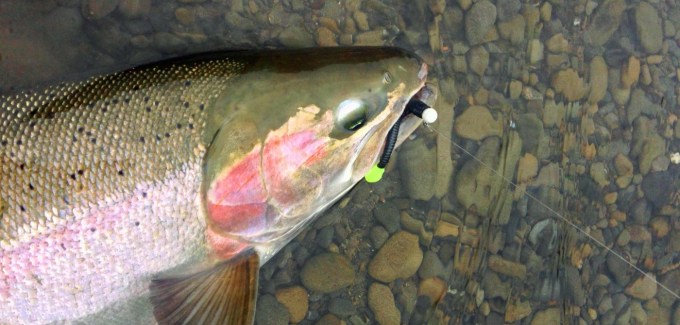
It’s funky looking…and quite frankly, a color scheme I would never in a million years have thought about using.
It’s just too odd: red, white and black.We are so conditioned as steelheaders that pinks and oranges are our friends — and this color scheme is so outside that “norm” that it’s hard to take it seriously.
But trust me when I say that the Nightmare color pattern is aptly named – it is one heck of a steelhead producer and should be in everyone’s arsenal.
But why?
When it comes to breaking down why critters with pea-sized brains do the things they do, it’s sometimes better to just accept the facts and move on without over-analyzing the situation. But in this case, I just can’t let it go. For some reason, the steelhead’s affinity for red, black and white has my left-brain working on overdrive (which, after the college party years is running low on disk space).
Okay, here’s my best guess: The black and red portion of the Nightmare kinda makes sense to me. I guess you can say it’s a little more natural – even sorta “buggy” looking.

Less intrusive than a lot of the fluorescent colors we fish, it may be able to “sneak up” on wary fish better than the bright stuff – especially in low, clear or pressured waters – yet still provide enough attraction to get fish to bite it. Kinda makes sense, right?
The white part, however, has me stumped. The only thing I can come up with is that it provides contrast when used in concert with the other two colors.
Okay, that’s all I’ve got. Time to get on the phone and ask around…
First, I called the very guy who I feel has caught more steelhead on jigs than anyone I know: Nick Amato, editor of Salmon Trout Steelheader Magazine. He’s also the person who helped me catch my first steelhead on a jig a million years ago.
“Geez, I donno why they like the Nightmare color,” said Nick. “I guess it kinda looks like a bug and has some natural color shades. Plus, you have the contrast in there…but who knows really why they bite it?”
My next call was to Jimmy Davis, owner of Mad River Manufacturing. He’s pumped out a bazillion Nightmare worms from his facility and I figured maybe some of his many customers might have shed some light on the subject.
“I’m no totally sure, but the Nightmare sure seems to get their attention,” he said. “I guess it’s the contrast for one. And maybe the more natural colors.”
At that point, I was sensing a pattern, but had one more call to make. I rang up Bob Kratzer, Owner of Angler’s Guide Service on Washington’s Olympic Peninsula. He fishes a ton of worms and jigs each year and is a big fan of the Nightmare. He’d surly have a good theory, right?
“Ha, ha, ha! I’ve got no idea why they eat that thing,” he said. “But it’s crazy how much they love the Nightmare. It’s gotta be the contrast and the color is more natural looking than bright pink.”
Bob also noted that a couple of his customers over the years have reported seeing natural worms in the gravel that wiggled away before being apprehended – worms that had a similar red hue to that of the Nightmare. So, there may be something to that but Bob’s never seen one himself.
After my phone work, I was feeling better that maybe my personal theories weren’t so hair-brained after all. The contrast and toned-down coloration was certainly a common theme. And that makes sense too when you consider that the consensus from my impromptu panel of experts was that the Nightmare is at its fishy best in low and clear water conditions.
But the bottomline is nobody really knows for sure why steelhead are drawn to this color pattern.
One thing’s for certain, however: steelhead love a good Nightmare!













 Continue to let line out at a controlled rate with your thumb until you get the plug and planer where you want them. As you can see, I have the planer working here near the opposite bank of a smaller river. Once in place, you can just hang out and wait for a fish to come to you or you can slowly walk downstream, back trolling like you would from a boat.
Continue to let line out at a controlled rate with your thumb until you get the plug and planer where you want them. As you can see, I have the planer working here near the opposite bank of a smaller river. Once in place, you can just hang out and wait for a fish to come to you or you can slowly walk downstream, back trolling like you would from a boat.




